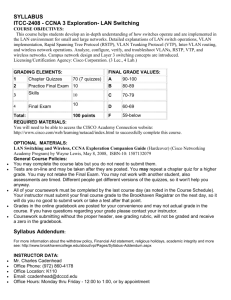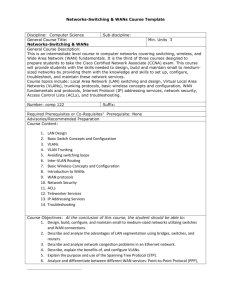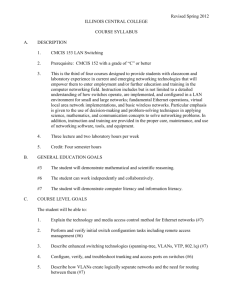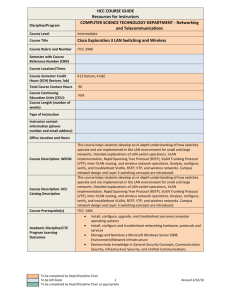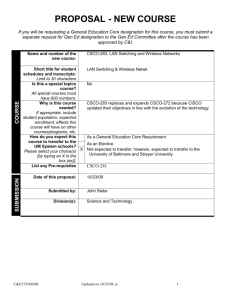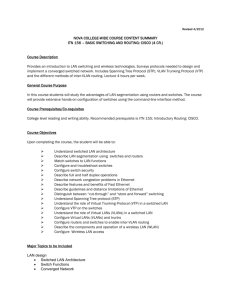COMF503
advertisement
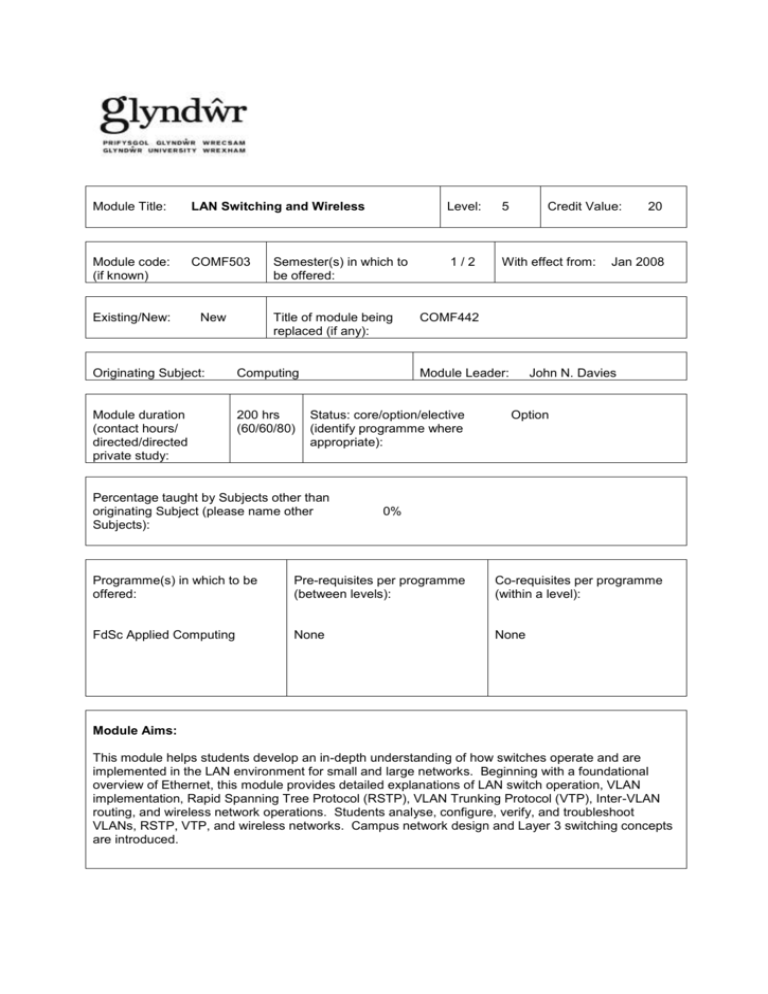
Module Title: LAN Switching and Wireless Level: 5 Module code: (if known) COMF503 1/2 With effect from: Existing/New: New Semester(s) in which to be offered: Title of module being replaced (if any): Originating Subject: Computing Module duration (contact hours/ directed/directed private study: 200 hrs (60/60/80) Credit Value: Jan 2008 COMF442 Module Leader: Status: core/option/elective (identify programme where appropriate): Percentage taught by Subjects other than originating Subject (please name other Subjects): 20 John N. Davies Option 0% Programme(s) in which to be offered: Pre-requisites per programme (between levels): Co-requisites per programme (within a level): FdSc Applied Computing None None Module Aims: This module helps students develop an in-depth understanding of how switches operate and are implemented in the LAN environment for small and large networks. Beginning with a foundational overview of Ethernet, this module provides detailed explanations of LAN switch operation, VLAN implementation, Rapid Spanning Tree Protocol (RSTP), VLAN Trunking Protocol (VTP), Inter-VLAN routing, and wireless network operations. Students analyse, configure, verify, and troubleshoot VLANs, RSTP, VTP, and wireless networks. Campus network design and Layer 3 switching concepts are introduced. Expected Learning Outcomes At the end of this module, students should be able to: Knowledge and Understanding: 1. 2. 3. 4. 5. Apply the main principles of switching and switch configuration to LAN design Define the main purpose and concepts underpinning the Spanning Tree Protocol Demonstrate and apply VLAN concepts to configure a VLAN using Virtual Trunking Protocol Analyse, configure, verify, and troubleshoot VLANs, RSTP, VTP, and wireless networks. Identify and describe the purpose of the components in a small wireless network. (SSID, BSS, ESS) 6. Identify the basic parameters to configure on a wireless network to ensure that devices connect to the correct access point. 7. Compare and contrast wireless security features and capabilities of WPA security(open, WEP, WPA-1/2) 8. Identify common issues with implementing wireless networks. (interference, misconfiguration ) Transferable/Key Skills and other attributes: learn independently, enhancing their existing skills and developing new ones to a high level, enabling them to sustain their own continued professional development demonstrate creativity in problem solving and decision making in complex and unpredictable solutions communicate information, ideas, arguments, problems and their solution in both written and oral form to specialist and non-specialist audiences demonstrate initiative, personal responsibility, personal enterprise, self reliance and self direction, acting autonomously in planning and implementing tasks at a professional level manage their time and resources efficiently Assessment: Students will be continuously assessed through their practical work on the course (50%) and by an online multiple choice test (50%). Assessment Type of assessment Weighting Duration (if exam) 1 Learning Outcomes to be met 1,2.5,6,7,8 MCQ 50% 1.5hrs 2 1,3,4,6 Practical Work 50% 2 hrs Word count or equivalent if appropriate Learning and Teaching Strategies: The module is taught using a structured programme of online learning, mini-seminars, tutorials, practical exercises and student-centred learning specifically: Self-directed learning using on-line material and lectures to supplement on-line material On-line multiple choice tests to give formative feedback Lab sessions to gain practical networking experience and re-enforce theory Individual assignment work as part lab work and skills test Web based research Syllabus outline: Troubleshooting common network problems at Layers 1, 2, 3, and 7 using a layered model approach Interpreting network diagrams Performing and verifying initial switch configuration tasks including remote access management Configuring, verifying, and troubleshooting VLANs, interVLAN routing, VTP, trunking on Cisco switches, and RSTP operation Managing IOS configuration files Identifying the basic parameters to configure a wireless network and common implementation issues Bibliography (please submit in Harvard referencing format) Lewis W., (2007) , LAN Switching and Wireless, CCNA Exploration Companion Guide, Cisco Press Other indicative reading: Dye M. ,McDonald R., Rufi A., (2007), Network Fundamentals, CCNA Exploration Companion Guide, Cisco Press Irving P., (2007), Computer Networks, Lexden Publishing Odom W, (2007) Computer Networks first-step, Cisco Press Johnson A., Routing Protocols and Concepts: CCNA Exploration Labs and Study Guide , Cisco Press Vachon B., Graziani R., (2007) Accessing the WAN, CCNA Exploration Companion Guide, Cisco Press.

